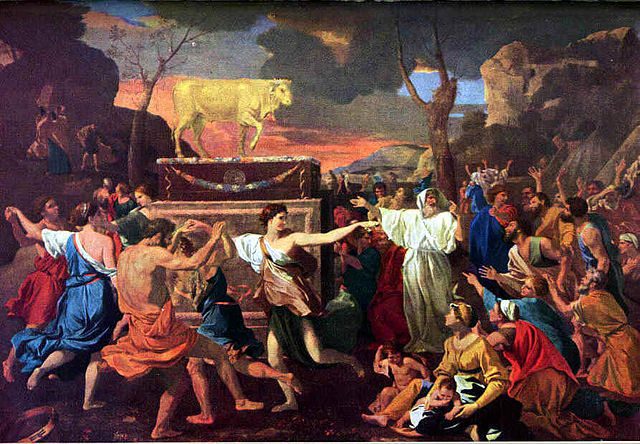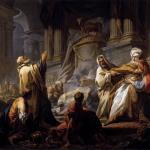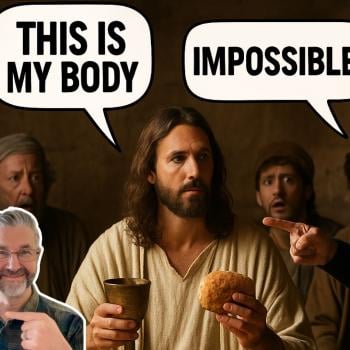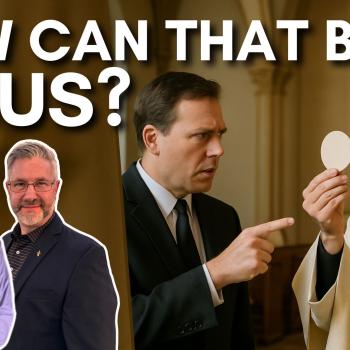
***
So apparently they were worshiping the true God, with the same name revealed to Moses, who led them out of Egypt. Thus, they were consciously worshiping the eternal GOD, as far as they were concerned, not a golden calf – the very opposite of idolatry, as you have defined it. So what was Moses so mad about?
These Israelites (unlike Catholics) were guilty of true idolatry. I think God (and Moses) know idolatry when they see it, don’t you? In Exodus 32:1, the NRSV reads, “Come, make gods for us, who shall go before us……” (cf. 32:23)
Exodus 32:4-5 informs us:
- He took the gold from them, formed it in a mold, and cast an image of a calf; and they said, “These are your gods, O Israel, who brought you up out of the land of Egypt!” When Aaron saw this, he built an altar before it; and Aaron made proclamation and said, “tomorrow shall be a festival to the LORD.”
It is, therefore, clear that this is idolatry and otherwise sinful, on many counts:
1) It represents not even the one God, but “gods,” so that it falls under the absolute prohibition of polytheism which was known to any observant Hebrew (see, e.g., Ps 106:19-23; cf. Hab 2:18).
2) Nowhere are the Jews permitted to build a calf as an “image” of God. This was an outright violation of the injunctions against “molten images” (Ex 34:17; Lev 19:4; Num 33:52; Dt 27:15: all condemn such idols, using the same Hebrew word which appears in Ex 32:4, 8, 17: massekah).
3) Aaron built an altar before what the people regarded as “gods,” thus blaspheming the true God.
4) Lies were told and believed about “gods,” not God, liberating the Hebrews from Egyptian slavery.
5) So Aaron used “orthodox” God-language, too. Does that release him from his responsibility? Obviously Aaron was a theological liberal, in his dishonest, equivocating use of language.
6) NASB and NKJV read “god” at Ex 32:4 (not even capitalized), so that is clearly not intended as a reference to the one true God, YHWH, according to the accepted practice of all Bible translations. NRSV, KJV, RSV, NIV, NEB, & REB have “gods.” In either case, the view is not monotheistic, nor is it at all analogous to the belief and practice of those Christians who accept the Real Presence.
In the latter instance, Christians are merely following Christ’s instructions at the Last Supper, as to a “memorial” of Him (which idea doesn’t necessarily exclude the Real Presence, as is often wrongly assumed). We find many explicit indications in Scripture that what He intended was a literal, miraculous, physical presence.
Furthermore, in Catholic, Orthodox, Lutheran and High Church Anglican belief, the Real Presence is not brought about by a “work of magic” on the part of the priest or pastor, nor the “work of men’s hands,” as is the case with the golden calf. Rather, it is a supernatural transformation wrought by God, in which the priest merely stands in as an alter Christus. So my original point stands unscathed.
Translations are divided on translating this “god” or “gods.” The problem is inherent in the word elohim, used here. It’s impossible to prove that “god/s” here were false gods, because the same word used here for “god/s” is the same word used in Deuteronomy 6:4: “Hear, O Israel! The Lord is our God, the Lord is one!” So the word tells us nothing one way or the other; we must rely on context. And in context, this golden calf was called “YHVH” (Ex 32:4) [actually, I’m sure he was referring to 32:5] and the one “who brought you up from the land of Egypt” (Ex. 32:4). This is the objection I would like for you to address.
Gladly. As for the use of “LORD” in v.5, see the three Protestant sources cited below and my additional comment for my reply on this point. You are of course correct about the multiple uses of elohim. However, you haven’t addressed the consideration that virtually all translations (Moffatt being the only exception I could find) render it as “god” or “gods” (i.e., lower-case “g”). Now, any Bible student knows that the lower-case “g” in the word “god” is a reference to false gods, which are no gods at all, in the monotheistic conception. Accordingly, all of the Hebrew scholars who produced all these translations have made a previous judgment as to which sort of “god” is being spoken of here, and they have concluded that it is not YHVH, the true God.
Why and how would they do that, according to you? If you want to disagree with all that scholarship, go ahead, but I won’t, since I don’t know Hebrew and thus defer to their “authority” on this matter. If you still want to maintain that YHVH is the referent in 32:4, then please produce for me one other instance in the Bible where YHVH, the true, eternal Creator God is translated as “god.” To me this is fairly conclusive in and of itself.
The use of “gods” in many versions and “god” in others is not enough for you to admit what is being spoken of here? It is a simple linguistic matter, which has been solved for us even before we have recourse ourselves to contextual considerations. But if you want context, I’ll give you context, and that, too, will prove to be conclusive in favor of my interpretation:
1) Exodus 32:1 (cf. 32:23), quoted above, is revealing as to the state of mind of these idolaters. They ask Aaron to “make” them “gods.” Obviously, they could not have YHVH in mind at that point, since I imagine they at least knew that He is not “made by hands” and is eternal. Then they say these gods “shall go before us.” In my opinion, , the most straightforward interpretation of that is the golden calf being carried before them. How could they think (even in their debased state of mind) that YHVH Himself could be compelled to “go before them?” Therefore, they must have regarded the calf as a pure idol of their own making, not as a mere representation of the true God, because these contextual verses make clear that they didn’t have YHVH in mind.
2) Exodus 32:23 is another indication of their state of mind, which was a lack of faith in God’s designs and purposes and impatience in waiting for Moses to come down from Mt. Sinai (cf. 32:1a). It is yet again a disbelief in and distrust of YHVH (what else is new?). They “don’t know what has become” of Moses, and ungratefully attribute to him the feat of bringing them “out of the land of Egypt,” whereas the credit should have gone to YHVH (cf. 32:11). Both of these factors mitigate against a “calf-symbolic-of-God” scenario and tend towards the notion of a pagan idol not representative of the true God. Your scenario would entail a state of affairs where they were mad at God ans Moses, so as a result they proceeded to worship God as a Golden Calf. What sense does that make?
3) If the above data isn’t sufficient, surely Psalm 106:19-21 (to which I referred in my original post, cited above) nails down my case (NRSV):
- They made a calf at Horeb and worshiped a cast image. They exchanged the glory of God for the image of an ox that eats grass. They forgot God, their Savior, who had done great things in Egypt.
Now, I want to know how they could “forget” the true God, whose glory they “exchanged” for the idolatrous image, while at the same time, in your view supposedly worship YHVH under the form of the golden calf? That is simply nonsensical. So both context and direct cross-reference support my view, not yours.
4) For this and the other reasons I’ve outlined yesterday and today, the analogy to the Real Presence in the Eucharist completely fails. And this is one reason why I wrote about the state of mind of the Catholic at Mass (which is important after all, since idolatry involves states of mind). The devout, orthodox Catholic is certainly not angry, distrustful, or “forgetting” God during the consecration, but rather, worshiping Him and giving him all the glory, and “remembering” Him, too, just as Jesus explicitly commanded. You must grant us at least that much, for this is a separate issue from whether or not a supernatural change occurs or not. And a Protestant may acknowledge that without compromising their own belief on the subject at hand, as I used to do.
5) To conclude my analysis of Exodus 32, I shall cite three reputable Protestant sources in favor of my interpretation:
a) William F. Albright (the dean of biblical archaeologists), From the Stone Age to Christianity, Garden City, New York: Doubleday, 2nd edition, 1957, pp. 264-6:
Yahweh, on the other hand, is virtually always referred to in the earlier sources in a way which suggests His human form though His body was usually hidden in a refulgent envelope called His Glory [cites Ex 33:23] . . .
In spite of the unanimous testimony of Israelite tradition, scholars have made repeated efforts to prove the existence of representations of deity in early Israel. Every effort of this kind has been based on subjective arguments and on arbitrary assumptions which have won only the most limited acceptance even in friendly circles . . . The testimony of our written sources, plus the completely negative results of excavation, should be evidence enough to prove that Yahwism was essentially aniconic and that material representations were foreign to its spirit from the beginning. We shall show below that there is no basis whatever for the idea that Yahweh was worshipped in bull form by the northern tribes at Bethel and Dan. The golden calf simply formed the pedestal on which the invisible Yahweh stood, just as in the Temple of Solomon the invisible Glory of God was enthroned above the cherubim; conceptually the two ideas are virtually identical.
b) Merrill F. Unger, Archaeology and the Old Testament, Grand Rapids, Michigan: Zondervan, 1954, pp. 236-237:
Although it has commonly been assumed that the ‘golden calves’ were direct representations of Yahweh as bull-god, it is scarcely conceivable that Jeroboam would have resorted to such a crude and violent departure from Yahwism . . . Besides, such a gross conception is otherwise unparalleled in Biblical tradition, and is opposed to archaeological evidence . . .
Although conceptually there is little difference between representing the invisible Deity as enthroned on the cherubim (1 Sam 4:4; 2 Ki 19:15) or as standing on a bull . . ., nevertheless Jeroboam’s innovation was extremely dangerous. The bull affiliations of Baal, lord of heaven, were too closely connected with the more degrading aspects of pagan cults to be safe, and there is every indication that the Northern Kingdom fell prey to idolatrous pollution as a result.
c) J. D. Douglas, editor, The New Bible Dictionary, Grand Rapids, Michigan: Eerdmans, 1962, p. 180:
It is possible to view the idolatry at Sinai as a blending of contemporary, popular bull- and calf-cults. Egyptian and Canaanite alike…..In any case, it represented a reduction of the God of Israel (cf. ‘feast to the Lord’, Ex 32:5) to the status of an amoral (tending to immoral) nature-god like those of the surrounding nations, and meant that He could then all too easily be identified with the Baals. This God rejected……condemning it as the worship of an ‘other’ god, and therefore idolatry (Ex 32:8).
Note that even if there was a certain sense of identification of the calf with God Himself, on the part of Aaron and the people, yet in reality this “God” has been “reduced” to what is in fact another “god,” so that they are still not worshiping the true God, YHVH, as The New Bible Dictionary asserts. It is only in this extremely limited sense (basically, in name only) that the calf can be regarded as representing YHWH, and it is in this sense alone that any scholars who equate it with “God” are speaking (e.g., Eerdmans Bible Commentary, p. 137, which also mentions “polytheism” in the same context.
But this ersatz identification is not sufficient in the least to establish your analogy to the Real Presence, which is what started all this, because Catholics, Orthodox, Anglicans and Lutherans do not “reduce” God at all in believing in a literal Eucharist. The analogy fails, pure and simple.
They were forbidden to worship any man-made image of God, whether the true God or false gods. Who bakes the bread at your parish?
Bread and wine are legitimate elements as determined by the commands of Jesus Himself, vastly unlike the Golden Calf. The Real Presence is established — we think — by Scripture, so worship follows as a matter of course. And men don’t bring about the change of transubstantiation. God does, and anyone who states differently about Catholic theology doesn’t know what he is talking about (see, e.g., Catechism of the Catholic Church, #1375, pp. 346-347, which cites Chrysostom and Ambrose). So again, there is no analogy.
In any case, I accept the Real Presence of Christ, but as a Spiritual presence, mediated by the Holy Spirit, rather than physical.
Why do you believe it is spiritual rather than physical and spiritual? Do you even allow for the theoretical possibility of a Real Presence in our sense? If not, that gets back to the possible influences of various heresies which I mentioned earlier. In any event, you must work through the biblical evidence and the unanimous history of the doctrine of the Eucharist before 1517.
Also, you are correct that our views on the sacraments do affect our views of the incarnation. Logically, if Christ was truly human, then his body can only be in one place at time. This is inherent to being human. His resurrected, glorified body is now at the right hand of the Father in heaven, and will remain there until he returns to judge the living and the dead. A “truly human” body which is both in heaven and scattered across the earth as a physical presence in bread ceases to be a human body. Both Luther and Rome have erred on this point.
A “truly human” body could walk through walls (Jn 20:19), and on water, could “vanish” (Lk 24:31), rise from the dead, descend into Hades and ascend to heaven, be conceived without benefit of a man, will come again and somehow “every eye shall see him,” etc., yet He could not be physically present in the Eucharist? Huh? Who are you to presume what the God-Man can and cannot do, anyway? At this point, it seems to me that you are adopting empirical rationalism, and are guilty of the same sort of unfounded hostile presuppositions which, in my humble opinion, produced a symbolic Eucharist in Zwingli’s mind in the first place, following the old heresies.
One can only determine by virtue of Scripture (and for some of us, also Tradition which is intrinsically intertwined with that Scripture, and it fact produced it itself, humanly speaking), what the truth about the Lord’s Supper (or for that matter, the Hypostatic Union) is, not by poorly grounded metaphysical presuppositions such as these, which mean little when it comes to the Omnipotent God.
Lastly, the Real Presence is often said by evangelicals to not be demonstrably, or “empirically” verifiable (e.g., Norman Geisler in his Roman Catholics and Evangelicals [Grand Rapids, Michigan: Baker Books, 1995], p. 265), hence, not a miracle, and not true. But if this be the case, then, e.g., the Virgin Birth and the Atonement of Christ on the Cross for our Redemption fall by the same token, for neither is “empirically” verifiable, yet they are two of the cardinal doctrines of Christianity, and both spectacularly miraculous.
Nor is the Hypostatic Union itself empirically verifiable — another extraordinary miracle and decidedly unnatural. What the observer at the Crucifixion even the disciples (all?) — saw as a wretched, meaningless execution and the end of all their hopes and aspirations, was in fact the greatest miracle in history, but it was not “empirically knowable,” as Geisler irrationally demands for the Eucharistic Real Presence.
Why not address the Protestant objection accurately? It makes no sense to speculate on why Protestants have difficulty accepting matter as a means to convey grace, when Protestants do not accept that grace is a substance to be conveyed. To assume that it is based on a heretical tendency against the physical world is fallacious, when that question never even enters into the debate. The only purpose I can see in it is to attach some heretical tags to Protestantism. If this is the purpose, then just quote the Council of Trent.
I was simply speculating, and that, admittedly, subjectively. What else am I supposed to do? If you can call us idolaters, and that’s perfectly permissible and okay, because it’s “biblical” argumentation, then I reserve the right to speculate as to Protestant objections to sacramentalism and possible Docetic tendencies. I don’t see how one speculation is any worse or objectionable than the other.
***
(originally 1996)
Photo credit: The Adoration of the Golden Calf (c. 1634), by Nicolas Poussin (1594-1665) [public domain / Wikimedia Commons]
***













